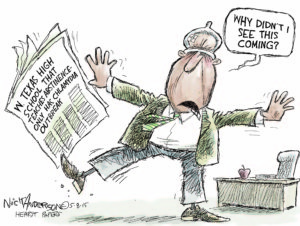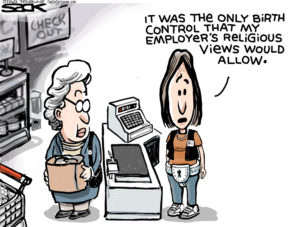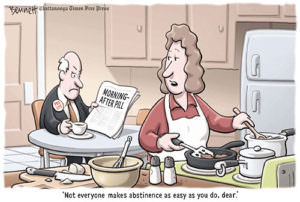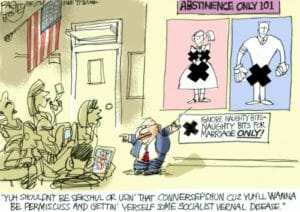Political Foolishness and Teen Pregnancy
The decline in contraceptive use may cheer those who have promoted faith-inspired school curricula, but now we have sad and clear evidence that political foolishness among adults is leading to foolish and harmful behavior among kids.It hardly seems worth mentioning that the search for role models of sexual rectitude has gone pretty badly lately. That famous poster of Farrah Fawcett — her golden locks tumbling around her shoulders and her gleaming smile offering a girl-next-door counterpoint to the suggestiveness of her red swimsuit — sure makes it look as though, by comparison, the 1970s were an era of wholesomeness.
They weren’t.
It was about then that social conservatives — fed up with sex, drugs, rock ’n’ roll, divorce, Roe v. Wade, women surging into the work force and who knows what else — began organizing politically to stamp out all this threatening change. They failed. But eventually they did succeed in imposing their prescription — abstinence-only sex education that studies have repeatedly shown doesn’t work — on the one group of sexually active people most in need of hard information and least likely to respond to harangues: teenagers.
It is widely known that teenage birth and pregnancy rates, which dropped dramatically between 1991 and 2005, are now climbing. By tracking changes in reported contraceptive use among sexually active high school students, researchers at Columbia University and the Alan Guttmacher Institute, which studies sexual health, have identified as the leading culprit a drop in the use of birth control — specifically condoms.
The team studied trends in teen sexual activity and contraceptive use between 1991 and 2007. During most of this period, the level of sexual activity reported by teenagers in routine surveys overseen by the Centers for Disease Control remained largely unchanged. But during a crucial period — identified in the study as between 1991 and 2003 — the use of condoms rose dramatically, climbing from 46.2 percent in 1991 to 63.0 percent in 2003. Then a perceptible decline in the use of condoms began, with 61.5 percent of students reporting condom use in 2007.
“These behavioral trends are consistent with the 2006 and 2007 increases in the teen birth rate,” the study published in the July issue of the Journal of Adolescent Health says. “They may well portend further increases in 2008.”
The decline in contraceptive use may cheer those who have promoted faith-inspired school curricula that refuse to even mention birth control and, in some cases, specifically emphasize that condoms can fail. True enough.
But now we have sad and clear evidence that political foolishness among adults is leading to foolish and harmful behavior among kids. Who could reasonably want more teen pregnancies, more abortions among teenagers, more unmarried mothers, more babies born with greater health risks and with the sorely limited economic prospects that burden the children of young, single mothers? No one would dare promote such a policy. Yet these are the results of our recent national sex education policy, which was based on religious faith, not science, and put political gamesmanship ahead of public health.
President Barack Obama’s budget would eliminate funding for abstinence-only education programs that show no results in changing teenagers’ behavior. That’s a proper step, but only a first one.
The same researchers who documented the drop in condom use link the decline in part to waning public concern about transmission of HIV, the virus that causes AIDS. The clear increase in the proportion of teenagers using condoms came during years when public health and media messages about the dangers of HIV were at a height. The more recent trends, the researchers write, “may suggest faltering of HIV prevention efforts among U.S. youth.” That is a dire warning of tragically diminished futures and early deaths among a generation that shouldn’t be condemned to such suffering.
In the past few months, we’ve experienced near hysteria over swine flu and almost constant media attention to scares about tainted food. These are genuine health hazards — but they aren’t necessarily deadly, nor do they affect nearly as many people in the United States and around the world as does AIDS. The difference, of course, is that you get HIV from having sex or using drugs intravenously, not from unwittingly eating a bad burger or sitting next to a flu carrier.
You can argue, based on hard data, that when it comes to teenagers and sex, good policy and genuine leadership get better results than moralizing or ignoring signals that an upsurge in HIV infections may emerge. The tragic lesson of the earliest days of the AIDS pandemic is that squeamishness is no substitute for common sense.
Marie Cocco’s e-mail address is mariecocco(at)washpost.com.
© 2009, Washington Post Writers Group
Your support matters…Independent journalism is under threat and overshadowed by heavily funded mainstream media.
You can help level the playing field. Become a member.
Your tax-deductible contribution keeps us digging beneath the headlines to give you thought-provoking, investigative reporting and analysis that unearths what's really happening- without compromise.
Give today to support our courageous, independent journalists.






You need to be a supporter to comment.
There are currently no responses to this article.
Be the first to respond.